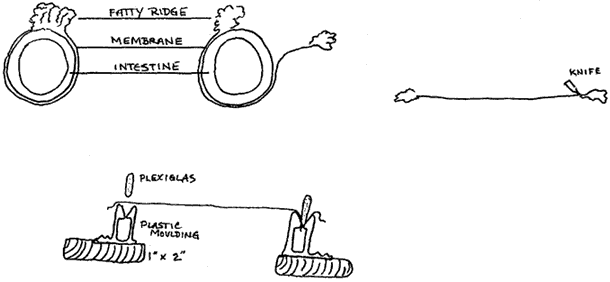Notes on the Manufacture of Goldbeater's Skin
by Jack C. ThompsonOne of the traditional materials used in the repair of manuscripts written on vellum is goldbeater's skin, the outer membrane of ox intestine. The advantages of this material are transparency, strength and fairly uniform thickness.
Unfortunately, very little information has been published regarding its manufacture.1 Therefore, when the intestines of a freshly slaughtered ox became available, I decided to determine empirically how goldbeater's skin is manufactured.
The intestines, having been cut into sections and hosed clean of offal, arrived in the lab filling two five gallon plastic pails. A considerable quantity of mucous was present, and there was some blood. Literature concerning the manufacture of sausage casings from hog intestines indicated that salt was used to remove blood from these; so approximately one pound of salt was added to each five gallon bucket of ox intestines, and the buckets were closed.
After a day the buckets were reopened and the intestines were examined and found to be substantially free of blood. The mucous in the intestines .had not been idle during this time, and I would recommend to anyone wanting to duplicate this work, that they lay in a supply of clove oil or Lysol spray disinfectant as well as a good tight-fitting mask with fresh filters .
Begin separating the membrane from the wall of the intestine by peeling apart the ridge of fat which runs alongside. Once started, the membrane peels fairly easily until there is a narrowing or turn to the intestine, or, until the fatty ridge comes to an end. Some of the pieces removed were only a few inches long while others were nearly two feet long.
The membranes were rinsed in running water as the fat was pulled or scraped off, and then put in water to soak. Since ox intestine are in fairly short supply it was necessary to devise a method for stretching and drying the membranes with the least amount of waste. To accomplish this, I made a framework of plastic inside storm window mouldings mounted on 1" x 2" sticks. The membrane was stretched over these mouldings and held in place with strips of 1/8" Plexiglas. As it dried, the membrane tightened up and became clear.
When the tension is released by cutting the membrane free of the drying rack, it shrinks slightly and becomes somewhat wrinkled, but this may be prevented by treating it with a light application of surgical jelly; I have not tried the method referred to by Dr. Ure, reprinted below.
While I was working with the intestine, I was advised that goldbeater's skin. could be made from organ membranes2 such as liver,. but have not had the opportunity to test that information.
As far as other. animal sources for goldbeater's skin, "Not all cattle provide material suitable for this purpose. Well-nurtured animals usually have too much fatty tissue associated with the caecum which prevents thin layers from being easily separated so that generally the leaner and more undernourished types furnish better starting material. The processing of cattle caecum is necessarily an unsavoury business ... "3 Amen!
A 15 minute videotape recording this manufacturing process has been produced by Istor Productions, Portland, Oregon, 1983.
References
1. Examination of 61 publications revealed these items with at least some qualitative value:
Barnes, Richard H. Gilding and the Making of Gold Leaf. 1962. pp. 31-35.
Bigelow, Jacob. The Useful Arts, Vol. I. Boston: Marsh, Capen, Lyon and Webb, 1840. pp. 144-145.
I.C.S. Reference Library, 202: Packing-house Industries, Manufacture of Soap. Scranton, PA: International Textbook Co., 1905. pp. 58-59, Section 19.
Karmas, Endel. Sausage Casing Technology. Park Ridge, NJ: Noyes Data Corp. , 1974.
Reed, R. Ancient Skins Parchments and Leathers. London: Seminar Press, 1972. pp. 130-131.
Stambelov, T. Manufacture, Deterioration and Preservation of Leather. Amsterdam: International Council of Museums, 1969. pp. 71.
Ure, Andrew. Dictionary of Arts, Manufactures, and Mines. Vol. I. New York: D. Appleton, 1858. pp. 948-950.
2. Joe Nkrumah, personal communication, 3 January 1983. goldbeater's skin
3. Ancient Skins, ibid, pp. 131.
Jack C. Thompson"The skin of the gold-beater is a pellicle separated from the outer surface of ox-gut; but before being employed for this purpose, it must undergo two preparations. 1. It is sweated, in order to expel any grease it may contain. With this view, each piece of membrane is placed between two leaves of white paper; several of these pairs are piled over each other, and struck strongly with a hammer, which drives the grease from the gut into the paper.
2. A body is given to the pieces of gut; that is, they are moistened with an infusion of cinnamon, nutmeg, and other warm and aromatic ingredients, in order to preserve them; an operation repeated after they have been dried in the air. When the leaves of skin are dry,, they are put in a press, and are now ready for use. After the parchment, vellum, and gut membrane have been a good deal hammered, they become unfit for work, till they are restored to proper flexibility, by being placed leaf by leaf between leaves of white paper, moistened sometimes with vinegar, at others with white wine. They are left in this predicament for 3 or 4 hours, under compression of a plank loaded with weights. When they have imbibed the proper humidity, they are put between leaves of parchment 12 inches square, and beat in that situation for a whole day. They are then rubbed over with fine calcined gypsum, as the vellum was originally. The gut-skin is apt to contract damp in standing, and is therefore dried before being used."
Ure, Andrew. Dictionary of Arts, Manufactures, and Mines, Vol. I. pp. 949-950.
Thompson Conservation Laboratory Portland, Oregon
